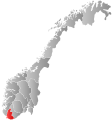Øvre Sirdal
Øvre Sirdal herred | |
|---|---|
 Øvre Sirdal within Vest-Agder | |
| Coordinates: 58°48′30″N 06°45′51″E / 58.80833°N 6.76417°ECoordinates: 58°48′30″N 06°45′51″E / 58.80833°N 6.76417°E | |
| Country | Norway |
| County | Vest-Agder |
| District | Lister |
| Established | 1 Jan 1905 |
| • Preceded by | Sirdal Municipality |
| Disestablished | 1 Jan 1960 |
| • Succeeded by | Sirdal Municipality |
| Administrative centre | Lunde |
| Area (upon dissolution) | |
| • Total | 1,156 km2 (446 sq mi) |
| Population (1960) | |
| • Total | 549 |
| • Density | 0.47/km2 (1.2/sq mi) |
| Demonym | Sirdøl[1] |
| Time zone | UTC+01:00 (CET) |
| • Summer (DST) | UTC+02:00 (CEST) |
| ISO 3166 code | NO-1047 |
Øvre Sirdal is a former municipality that was located in the old Vest-Agder county in Norway. The 1,156-square-kilometre (446 sq mi) municipality[3] existed from 1905 until its dissolution in 1960. It was located in the northern part of the present-day municipality of Sirdal in Agder county. The administrative centre was the village of Lunde where Lunde Church is located.
Name
The name "Øvre Sirdal" means "upper Sirdal" since it was created from the northern part of the old Sirdal municipality. The Old Norse form of the name was Sírudalr. The first element is the genitive case of the name of the river Síra and the last element is dalr which means "valley" or "dale". The meaning of the rivername is unknown (maybe "strong stream").[4]
History
The municipality of Øvre Sirdal was established on 1 January 1905 when the old Sirdal formannskapsdistrikt was split into two municipalities: Øvre Sirdal (population: 753) and Tonstad. During the 1960s, there were many municipal mergers across Norway due to the work of the Schei Committee. On 1 January 1960, Øvre Sirdal (population: 549) was merged with the neighboring municipality of Tonstad (population: 651) and the Øksendal area of the municipality of Bakke (population: 226) to form a new municipality of Sirdal.[5]
Government
All municipalities in Norway, including Øvre Sirdal, are responsible for primary education (through 10th grade), outpatient health services, senior citizen services, unemployment and other social services, zoning, economic development, and municipal roads. The municipality was governed by a municipal council of elected representatives, which in turn elected a mayor.[6]
Municipal council
The municipal council (Herredsstyre) of Øvre Sirdal was made up of representatives that were elected to four year terms. The party breakdown of the final municipal council was as follows:
| Party Name (in Norwegian) | Number of representatives | |
|---|---|---|
| Local List(s) (Lokale lister) | 13 | |
| Total number of members: | 13 | |
| Party Name (in Norwegian) | Number of representatives | |
|---|---|---|
| Local List(s) (Lokale lister) | 12 | |
| Total number of members: | 12 | |
| Party Name (in Norwegian) | Number of representatives | |
|---|---|---|
| Local List(s) (Lokale lister) | 12 | |
| Total number of members: | 12 | |
| Party Name (in Norwegian) | Number of representatives | |
|---|---|---|
| Local List(s) (Lokale lister) | 12 | |
| Total number of members: | 12 | |
| Party Name (in Norwegian) | Number of representatives | |
|---|---|---|
| Local List(s) (Lokale lister) | 12 | |
| Total number of members: | 12 | |
| Note: Due to the German occupation of Norway during World War II, no elections were held for new municipal councils until after the war ended in 1945. | ||
See also
References
- ^ "Navn på steder og personer: Innbyggjarnamn" (in Norwegian). Språkrådet.
- ^ "Forskrift om målvedtak i kommunar og fylkeskommunar" (in Norwegian). Lovdata.no.
- ^ Helland, Amund (1903). "Siredalen herred". X Lister og Mandals amt. Anden del. Norges land og folk (in Norwegian). Kristiania, Norway: H. Aschehoug & Company. p. 629. Retrieved 4 July 2022.
- ^ Rygh, Oluf (1912). Norske gaardnavne: Lister og Mandals amt (in Norwegian) (9 ed.). Kristiania, Norge: W. C. Fabritius & sønners bogtrikkeri. p. 350.
- ^ Jukvam, Dag (1999). "Historisk oversikt over endringer i kommune- og fylkesinndelingen" (PDF) (in Norwegian). Statistisk sentralbyrå.
- ^ Hansen, Tore, ed. (12 May 2016). "kommunestyre". Store norske leksikon (in Norwegian). Kunnskapsforlaget. Retrieved 22 November 2020.
- ^ "Kommunevalgene og Ordførervalgene 1955" (PDF) (in Norwegian). Oslo: Statistisk sentralbyrå. 1957. Retrieved 22 November 2020.
- ^ "Kommunevalgene og Ordførervalgene 1951" (PDF) (in Norwegian). Oslo: Statistisk sentralbyrå. 1952. Retrieved 22 November 2020.
- ^ "Kommunevalgene og Ordførervalgene 1947" (PDF) (in Norwegian). Oslo: Statistisk sentralbyrå. 1948. Retrieved 22 November 2020.
- ^ "Kommunevalgene og Ordførervalgene 1945" (PDF) (in Norwegian). Oslo: Statistisk sentralbyrå. 1947. Retrieved 22 November 2020.
- ^ "Kommunevalgene og Ordførervalgene 1937" (PDF) (in Norwegian). Oslo: Statistisk sentralbyrå. 1938. Retrieved 22 November 2020.
External links
 Vest-Agder travel guide from Wikivoyage
Vest-Agder travel guide from Wikivoyage- Sirdolen.no (in Norwegian)
- Weather information for Øvre Sirdal (in Norwegian)
- CS1 Norwegian-language sources (no)
- Articles with short description
- Short description with empty Wikidata description
- Coordinates not on Wikidata
- Articles containing Old Norse-language text
- Articles containing Norwegian-language text
- Articles with Norwegian-language sources (no)
- AC with 0 elements
- Use dmy dates from November 2020
- Sirdal
- Former municipalities of Norway
- 1905 establishments in Norway
- 1960 disestablishments in Norway


